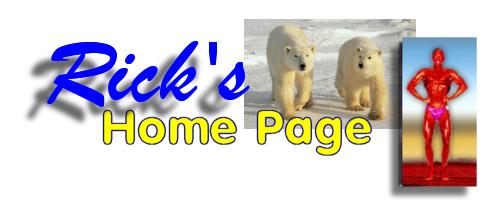|
The Greek-god 25
Minute Workout
|
| Chest:
Using barbells, dumbbells or machine, perform chest presses.
Start with 60% of the maximum amount of weight you can press and
increase the weight with each set. Remember to flex at
the top of the movement and slowly lower the weight, always keeping
in control. Do three sets of 8 to 12 reps. |
 |
| Back:
Pull downs - cable machine, or if unavailable, do pull ups.
If performing pull-ups with the cable machine Do three sets of
8 to 12 reps.
Neck: Barbell or dumbbell
shrugs. Stand upright holding on to the weight.
Let the weight hang in front of you then shrug your shoulders.
Try and isolate the trapezius. Do three sets of 8 to 12
reps.
|
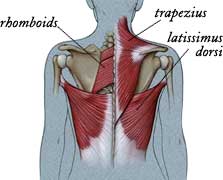 |
| Thighs:
Squats with barbell, dumbbells or machine. Start with a
warm up set using 75% of the weight you normally squat.
(Per workout, vary your stance - feet shoulder width apart for
one workout and feet together for another workout.) Add
the rest of the weigh with each additional set. Do three
sets of 6 to 10 reps. |
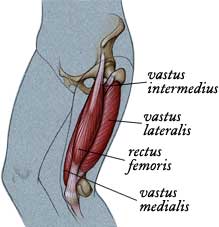 |
| Hamstrings:
Stiff legged-dead lifts. Start with a light weight get a
good stretch and gradually increase your weight with each rep.
Keep focused! You can blow-out your lower back with this
one. Do three sets of 6 to 10 reps. |
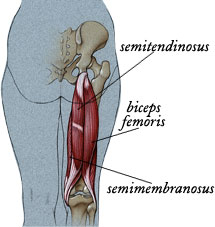 |
| Buttocks:
Walking lunges using dumbbells or barbells. Perform the
exercise so that you can get about 20 steps using a short stride
and then 10 - 15 steps using a long stride. Increase the
weight with each rep. Do three sets. Careful with
this one; if you're not used to it you will be sore the next day. |
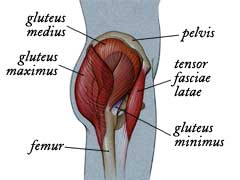 |
| Calf:
Standing calf raises with dumbbells or barbells. Stand on
a step on the balls of your feet and flex upward with your toes.
Come down with your heals going below the level of the step.
Do three sets of 15 to 25 reps each. |
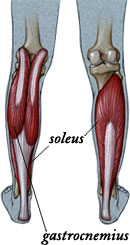 |
| Biceps:
Incline dumbbell curls. Sit on an incline bench. Holding
the weights, let your arms hang to the side and then curl up.
Do 10 to 15 reps each arm. |
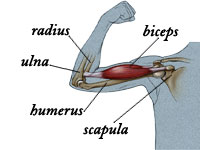 |
| Triceps:
Behind the neck extensions. Hold the dumbbell behind the
neck and then lift straight up. Flex the triceps.
Do 10 to 15 reps each arm. |
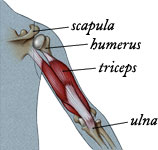 |
| Stomach:
Crunches and leg raises. Perform 3 sets of each. Do
10 to 15 reps for each exercise. |
 |
|
|
| This
is a marble sculpture of Kouros (standing
male figure) of Anavysos, 530 B.C. Kouros stands in
the National Archeological Museum, Athens Greece.
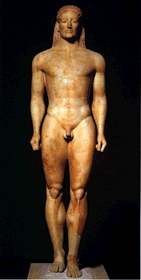 We
know the identity of the Kouros because of the inscription at
its base which reads, "Stand and mourn for Kroisos, first
in line of battle and whom Ares [god of war] killed." Clearly
the function of the statue is one of memorial. This one came
from a cemetery outside of Athens. Not all Kouros figures are
grave markers, though, some serve as memorials only, such as
at temple sites. Kroisos stands with one foot forward (like
Egyptian statues but for a different reason), in order to dedicate
himself or present himself to the god. He appears rather rigid,
frontal, and there is a stylized or formulaic approach to the
anatomy (fairly crisp divisions). Although Kroisos is an individual
this is not a portrait likeness, rather it is him at the peak
of his physical and intellectual development -- a hero-athlete.
The Greeks emphasized the importance of educating the mind as
well as training the body. Remember Protagoras' dictum will
be, "man is the measure of all things." We
know the identity of the Kouros because of the inscription at
its base which reads, "Stand and mourn for Kroisos, first
in line of battle and whom Ares [god of war] killed." Clearly
the function of the statue is one of memorial. This one came
from a cemetery outside of Athens. Not all Kouros figures are
grave markers, though, some serve as memorials only, such as
at temple sites. Kroisos stands with one foot forward (like
Egyptian statues but for a different reason), in order to dedicate
himself or present himself to the god. He appears rather rigid,
frontal, and there is a stylized or formulaic approach to the
anatomy (fairly crisp divisions). Although Kroisos is an individual
this is not a portrait likeness, rather it is him at the peak
of his physical and intellectual development -- a hero-athlete.
The Greeks emphasized the importance of educating the mind as
well as training the body. Remember Protagoras' dictum will
be, "man is the measure of all things."
The Greeks depicted man in what
they believed was the image of the gods and so would come to
celebrate the body by striving for verisimilitude or true-likeness
(realism and naturalism!). They were, at first, the only culture
in the ancient world to employ the nude.
Top of the
Page.
|
